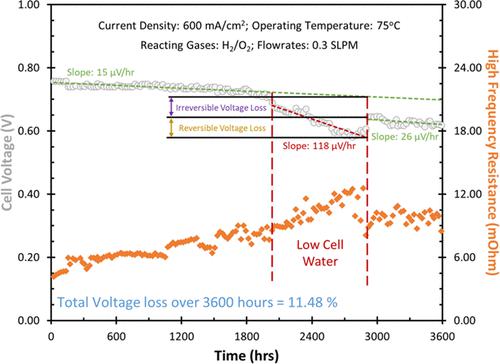当前位置:
X-MOL 学术
›
ACS Catal.
›
论文详情
Our official English website, www.x-mol.net, welcomes your feedback! (Note: you will need to create a separate account there.)
Understanding Recoverable vs Unrecoverable Voltage Losses and Long-Term Degradation Mechanisms in Anion Exchange Membrane Fuel Cells
ACS Catalysis ( IF 12.9 ) Pub Date : 2022-06-22 , DOI: 10.1021/acscatal.2c01880 Noor Ul Hassan 1 , Michael J. Zachman 2 , Mrinmay Mandal 3 , Horie Adabi Firouzjaie 1 , Paul A. Kohl 3 , David A. Cullen 2 , William E. Mustain 1
ACS Catalysis ( IF 12.9 ) Pub Date : 2022-06-22 , DOI: 10.1021/acscatal.2c01880 Noor Ul Hassan 1 , Michael J. Zachman 2 , Mrinmay Mandal 3 , Horie Adabi Firouzjaie 1 , Paul A. Kohl 3 , David A. Cullen 2 , William E. Mustain 1
Affiliation

|
Anion exchange membrane fuel cells (AEMFCs) have recently shown excellent progress in terms of their performance – e.g., achievable power and current density. However, very few AEMFCs have been demonstrated with the ability to operate for a long duration (>1000 h). In addition, it is unknown whether performance losses observed during operation are reversible, irreversible, or a combination of the two. In this study, a high-performance AEMFC operated continuously at 600 mA/cm2 for 3600 h (150 days) at 80 °C with H2/O2 reacting gases was demonstrated. Throughout testing, the electrochemical properties of the AEMFC were probed to provide information about performance degradation pathways and their degree of reversibility. It was found that a portion of the performance loss that occurs during AEMFC operation was due to suboptimal reaction conditions and can be recovered. At the end of the experiment, the cell was disassembled, and its structure and composition were evaluated at the nanoscale by aberration-corrected scanning transmission electron microscopy and energy-dispersive X-ray spectroscopy. The structure and composition of the electrode were compared to cells at the beginning of their operational life. It was found that the primary mechanism for long-term AEMFC performance loss was catalyst agglomeration. During the operational time, there was no evidence of significant polymer degradation, likely due to the high hydration state of the cell. By documenting the long-term changes in high-performing AEMFCs, this work provides important information for the systematic design of cell components and demonstrates the importance of controlling cell operation, which can aid in the commercialization and widespread deployment of low-cost, long-life AEMFCs.
中文翻译:

了解阴离子交换膜燃料电池中可恢复与不可恢复的电压损失和长期降解机制
阴离子交换膜燃料电池 (AEMFC) 最近在性能方面取得了显着进步——例如,可实现的功率和电流密度。然而,很少有 AEMFC 能够长时间运行(>1000 小时)。此外,尚不清楚在操作期间观察到的性能损失是可逆的、不可逆的还是两者的结合。在本研究中,高性能 AEMFC在 80 °C 下使用 H 2 /O 2以 600 mA/cm 2连续运行 3600 小时(150 天)反应气体被证明。在整个测试过程中,对 AEMFC 的电化学特性进行了探测,以提供有关性能退化途径及其可逆性程度的信息。发现在 AEMFC 运行期间发生的部分性能损失是由于反应条件欠佳造成的,并且可以恢复。在实验结束时,将电池拆解,并通过像差校正扫描透射电子显微镜和能量色散X射线光谱在纳米尺度上评估其结构和组成。电极的结构和组成在其使用寿命开始时与电池进行了比较。发现长期 AEMFC 性能损失的主要机制是催化剂聚集。在运营期间,没有证据表明聚合物显着降解,这可能是由于细胞的高水合状态。通过记录高性能 AEMFC 的长期变化,这项工作为电池组件的系统设计提供了重要信息,并展示了控制电池操作的重要性,这有助于低成本、长期的商业化和广泛部署。生活 AEMFC。
更新日期:2022-06-22
中文翻译:

了解阴离子交换膜燃料电池中可恢复与不可恢复的电压损失和长期降解机制
阴离子交换膜燃料电池 (AEMFC) 最近在性能方面取得了显着进步——例如,可实现的功率和电流密度。然而,很少有 AEMFC 能够长时间运行(>1000 小时)。此外,尚不清楚在操作期间观察到的性能损失是可逆的、不可逆的还是两者的结合。在本研究中,高性能 AEMFC在 80 °C 下使用 H 2 /O 2以 600 mA/cm 2连续运行 3600 小时(150 天)反应气体被证明。在整个测试过程中,对 AEMFC 的电化学特性进行了探测,以提供有关性能退化途径及其可逆性程度的信息。发现在 AEMFC 运行期间发生的部分性能损失是由于反应条件欠佳造成的,并且可以恢复。在实验结束时,将电池拆解,并通过像差校正扫描透射电子显微镜和能量色散X射线光谱在纳米尺度上评估其结构和组成。电极的结构和组成在其使用寿命开始时与电池进行了比较。发现长期 AEMFC 性能损失的主要机制是催化剂聚集。在运营期间,没有证据表明聚合物显着降解,这可能是由于细胞的高水合状态。通过记录高性能 AEMFC 的长期变化,这项工作为电池组件的系统设计提供了重要信息,并展示了控制电池操作的重要性,这有助于低成本、长期的商业化和广泛部署。生活 AEMFC。

























 京公网安备 11010802027423号
京公网安备 11010802027423号